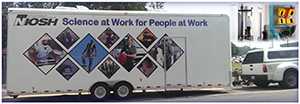ANTHROPOMETRY
NIOSH Labs
Partnering with stakeholders, we have applied the most current 3-dimensional digital scanning technology and developed improved body-shape quantification methods to advance anthropometry research which has provided a variety of enhanced equipment design recommendations.
Anthropometry Laboratory
 Changing human anthropometry (i.e., population composition, body size, body shape, and aging) in the American workforce requires that workplace layout, equipment, and personal protective devices be re-evaluated to accommodate diverse worker populations for effective injury prevention and control. NIOSH researchers use the NIOSH Anthropometry Research Laboratory to collect and quantify human body size and shape of various occupational groups for use in developing improved equipment designs for worker protection.
Changing human anthropometry (i.e., population composition, body size, body shape, and aging) in the American workforce requires that workplace layout, equipment, and personal protective devices be re-evaluated to accommodate diverse worker populations for effective injury prevention and control. NIOSH researchers use the NIOSH Anthropometry Research Laboratory to collect and quantify human body size and shape of various occupational groups for use in developing improved equipment designs for worker protection.
Equipped with a series of low-energy three-dimensional scanning devices, the lab was developed in 1995 and remains among only a few research facilities worldwide with similar capabilities and advanced technologies.
Four scanning systems – whole body, head, foot, and hand-held small object scanning – are available for use in a wide variety of research applications.
- The whole-body scanner has a resolution of 3 mm and requires only 17 seconds to complete a scan.
- The head scanner captures high resolution image of a subject’s head in just a few seconds.
- The foot scanner records a subject’s foot in 3-dimensional modes in a few second and reports linear dimensions of the foot as well.
- The hand-held scanner can be used to capture small stationary objects – such as tools and hands – or large objects – such as cab interiors.
Our scientists have developed a series of anthropometry study procedures for collecting anthropometry data, quantifying human body shape, and evaluating human-equipment interfaces for various protective equipment and workspace design applications.
Digital Modeling Laboratory
 The Digital Human Modeling Laboratory is the NIOSH focal point for digital human model development and computerized human-system interface research. The software industry, academia, and research organizations regularly use updated digital human models for biomechanical simulations, various computational health research applications, and product design. This lab allows for the development of digital human models of occupational populations for such applications. Compared to typical digital models of general civilian population and military personnel, the occupational models have distinct body dimensional features.
The Digital Human Modeling Laboratory is the NIOSH focal point for digital human model development and computerized human-system interface research. The software industry, academia, and research organizations regularly use updated digital human models for biomechanical simulations, various computational health research applications, and product design. This lab allows for the development of digital human models of occupational populations for such applications. Compared to typical digital models of general civilian population and military personnel, the occupational models have distinct body dimensional features.
The lab also incorporates high-end computer workstations and software applications for the establishment and analysis of digitized models of the human form. Software packages include JACK, Polyworks, ANSYS, ADAMS, and 3DS Max, among others. Developed in 1995, the lab features a series of digital models of farm tractor operators, truck trailer drivers, fall-arrest harness users, and firefighters.
Among the projects that used digital human models are:
- Farm tractor protective volume estimation
- Biomechanical assessment of lower extremity joint loading during drywall stilt use
- Development of truck driver body models for truck cab design
- Determination of eyewear protective coverage
- Design of ambulance compartments for emergency responders and patient safety
- Fall-arrest harness fit assessments
Mobile Anthropometry Laboratory
 Like the in-house Anthropometry Research Laboratory, the Mobile Anthropometry Laboratory contains a whole body and head scanner mounted inside a 30-foot trailer. The mobile lab also houses foot and hand scanners and space for traditional measurement using calipers.
Like the in-house Anthropometry Research Laboratory, the Mobile Anthropometry Laboratory contains a whole body and head scanner mounted inside a 30-foot trailer. The mobile lab also houses foot and hand scanners and space for traditional measurement using calipers.
This lab allows us to capture a broader demographic of workers from different geographic locations. Previous NIOSH studies on firefighters and truck drivers revealed the difficulty in recruiting subjects who reside more than 30 miles away from data collection sites. A mobile data collection unit provides a solution to reach out to target worker populations in a timely and cost-effective manner for ongoing and future projects. The trailer has been moved across the United States to capture different populations of workers, such as emergency medical service (EMS) workers.
Contact Person: Hongwei Hsiao, Ph.D.
Chief, Protective Technology Branch
Phone: (304) 285-5910
Email: HHsiao@cdc.gov
Other Laboratories
- Page last reviewed: April 12, 2017
- Page last updated: May 6, 2016
- Content source:
- National Institute for Occupational Safety and Health Division of Safety Research


 ShareCompartir
ShareCompartir
